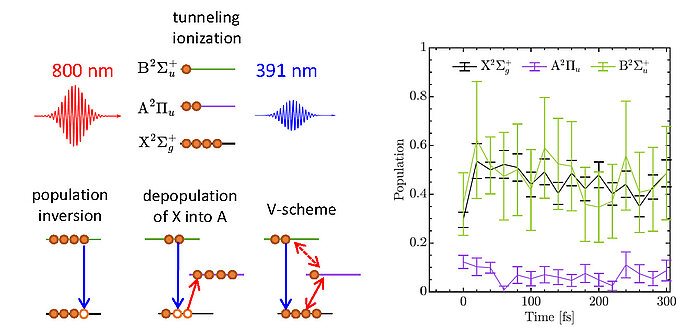The use of ultrashort laser pulses to induce and study ionization phenomena of small molecules is well established. Typically, the large electric field of a short intense pump pulse causes the ejection of an electron out of a molecule. Often several electronic excited states of the molecular ion may result, where the standard tunnel ionization mechanism predicts that the degree of excitation will be inversely proportional to the excitation energy (see Figure). For molecular nitrogen this would mean the X ground state will have a higher population than the A and B states. The basic rule for the lasing phenomenon, utilized in lasers (light amplification of stimulated emission of radiation), however, is that the population of the excited state should be higher than that of the ground state. For the N2+ molecules, this means a higher population in the B state than in the X state would be a necessary condition, contradicting the standard tunnel ionization model. An experimental verification of the time-dependent population of all three electronic states, that are understood to play a key role in lasing in ionized molecular nitrogen, has until now been lacking. One reason for that is that population changes of the X, A and B states could only be deduced from indirect probing at particular transitions between individual electronic states.
A state-of-the-art table-top laser based system generating ultrashort soft X-ray pulses tuned at the nitrogen K-edge has now been used at the Max Born Institute to simultaneously probe the time-dependent population of the X, A and B states (see Figure). Here the transitions of the 1s core to the valence molecular orbitals of N2+ are monitored in real-time. It turns out that directly after the ionization event the B state has a similar degree of excitation as the X state while the population of the A state remains remarkably low. With these results the role of the A state as a possible reservoir for a depletion of the X ground state can be excluded. Instead a coherent interplay of the light fields of the ionizing pump pulse at 800 nm and the lasing light field at 391 nm wavelengths, coupling the B, X and A states in a so-called V-scheme (see Figure), is the most plausible underlying mechanism for the observation of lasing in air upon interaction with intense femtosecond laser pulses. Such a interaction scheme enables the so-called lasing without population inversion mechanism.
The potential of the table-top laser-based experimental femtosecond soft X-ray spectroscopic method demonstrated by the team at the Max Born Institute will be further capitalized on by exploration of light induced molecular phenomena on time scales of the elementary steps in molecular rearrangements, in the gas phase and in solution phase.
